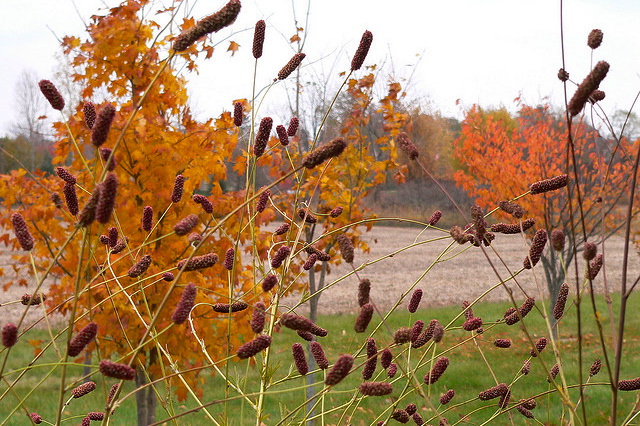View from the Garden: Year-Round Gardens Keep Flowers In Bloom

Most of the gardens in which I work are planted for summer interest, because that’s when the property is used. However, one of them was planted as a year-round garden, so I get to enjoy an abundance of early to mid-spring bulbs and also summer and fall bloomers. Because most of the plants available in the garden centers are for summer, one must really look for the following; ask if they can be ordered or get them online. They may also be available from a gardener who has access to wholesalers. The extra effort is worthwhile.
The lespedeza thunbergii is just beginning. When in full bloom, it’s a fountain of soft magenta. An older plant becomes a small shrub. It requires almost no maintenance. It only needs to be cut to the ground in the spring.
Sanguisorba tenuifolia “Purpurea” has a flurry of dark red/purple elongated bumble bee-like flowers dancing in the garden, especially beautiful against the last huge white flowers of hibiscus.
Two caryopteris are blooming to the delight of bees. Longwood Blue is effective as a short hedge or a small grouping. White Surprise is great as a feature plant. It has green and white leaves and small blue flowers around the stems in whirls. Longwood Blue has the same flower structure on stems with grey/blue leaves.
September is also the time to plant and transplant. Some local garden centers will be having sales soon. Look for healthy perennials and well-shaped trees and shrubs. Be sure that root balls of trees are not bone dry. Perennials may be root bound and need the roots to be disturbed when planted.
Though any perennials can be planted, spring and summer blooming plants are the ones to be transplanted now. This is the time to go through the garden and spot plants that have outgrown their spaces or any that were planted in the wrong place to make room for the new ones or to rearrange plants for interest.
I have divided and transplanted peonies when I had to correct all of the soil in their bed to ensure better drainage. Peonies do not need to be divided and as long as they are in a sunny spot with good drainage, and they can live there for many years. An old huge peony plant is a wonderful thing, and if it needs to be moved, it can be moved without dividing. If divided, each division should have 3–5 ‘eyes.’ Any fewer, and the plant will take several years to become a good bloomer. Be sure to get as much of the root system as possible, though this can be a challenge as they are deep. You will need the same deep hole at the new site and, most importantly, plant to a depth so that the buds are no more than 1–2 inches below the surface. Any deeper and they will not bloom.
Bearden iris need to be divided every two to three years to keep them healthy and blooming vigorously. This is also the time when borers and root rot can be dealt with by removing damaged rhizomes. Divide the rhizomes by breaking or cutting them into pieces with three or more eyes. Plant them so that the hump of the rhizome is just below the surface. Cut the fans back to about 4–5 inches. Remember that the plant will grow in the direction in which the fan is pointing.
Siberian and Japanese iris form clumps over time that are wide and empty in the middle. With care, remove the entire clump and with a sharp spade, cut the clump into pieces 5–6 inches wide, and replant.
Hostas can be divided and moved now, although a huge hosta is another wonderful presence in the garden. But perhaps it is in the wrong place. Cut apart the roots and replant. Do not plant in a place with wet soil.
Over the years, I have “stuck” plants into an available space in the garden or, because I did not read the label, planted a sun lover in too much shade. This is the perfect time to correct these situations and to add newly found jewels.
Jeanelle Myers is a professional gardener, landscaper and consultant. For gardening discussion you can call her at 631-434-5067.



